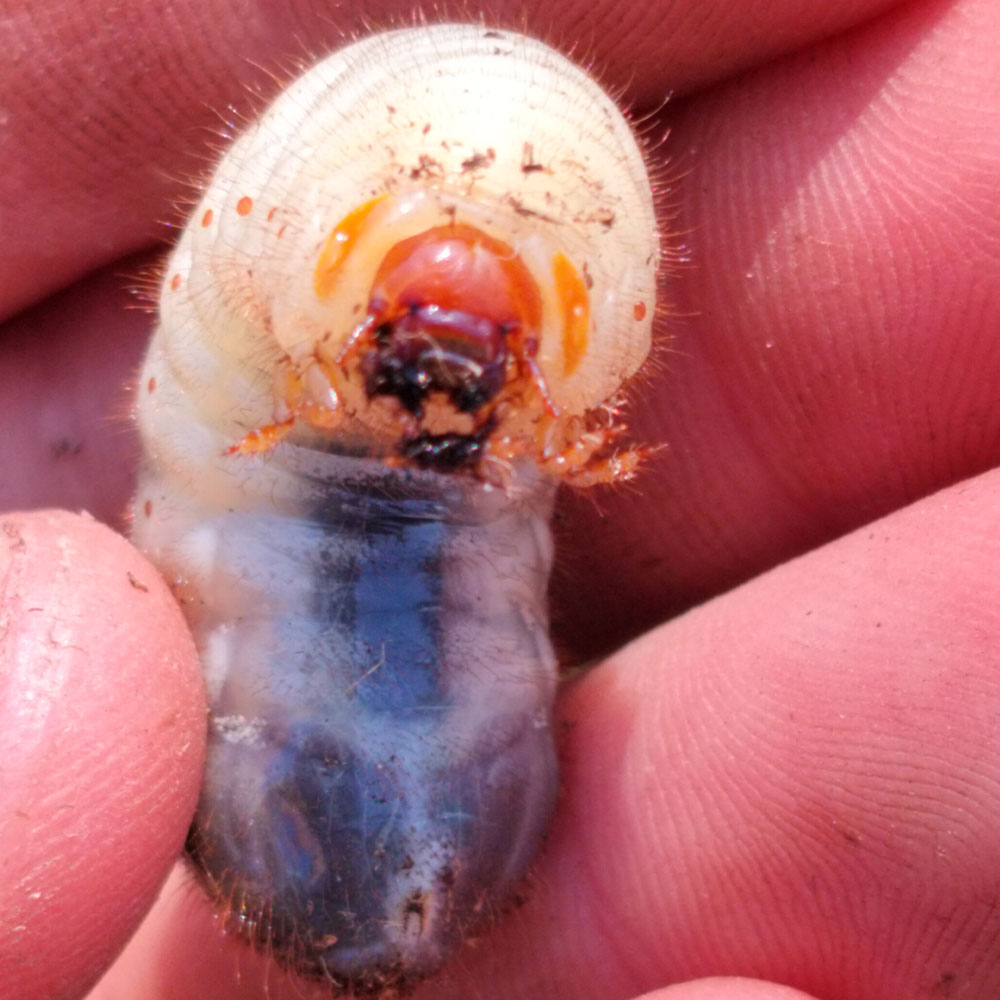No products in the cart.

🐛 The Rose Chafer Larva (Cetonia aurata)

The larva of the golden rose chafer (Cetonia aurata), shown here, is classified as a melolonthoid grub—related in form to the common cockchafer (Melolontha melolontha).
But one is beneficial to your soil and the other can become a pest.
Cetonia aurata larva thrives in decomposed wood, rich compost, and organic soil
- these larvae are invaluable for breaking down organic matter and contributing to fertile compost.
- It is invaluable in the creation of a healthy soil and a rich ecosystem.
Melolontha melolontha larva avoids compost and prefers feeding on roots underground
- known as the true white grub of the cockchafer
- feeds on roots at the larval stage and on plant leaves as an adult
- is considered a pest in large numbers
🔍 How to Identify the Rose Chafer Larva
- Larvae from compost: Below are photos of C. aurata larvae taken directly from my soil, including mature specimens and close-ups.
- Note the small head relative to the large, rounded abdomen—especially when seen from above or from the side.
- With time, they form a dense, almost cushioned body that can reach a considerable size, but the head remains teeny weeny.


🔍 How to Identify the Rose Chafer Adult
This species exhibits a wide range of color variations, often displaying a bright metallic green hue, sometimes tinged with red, and rarely with shades of blue, purple, or black.


The adult (or imago) is typically found in sunny areas from April to October, with peak activity between June and August, as it is a heliophilous (fancy word for sun-loving) species.
It is both nectarivorous and pollenivorous, feeding on flower stamens for their pollen (which results in the castration of the flowers), and sometimes consuming entire blossoms — such as those of wild or cultivated roses, fruit trees, elderberries, hawthorns, meadowsweet (Filipendula ulmaria), and Apiaceae (Umbellifers) like common hogweed (Heracleum sphondylium). It may also eat ripe fruits, making it frugivorous, especially on elderberries, roses, privet, or spirea.
Among the beetles that emerge within the same year, two generations can be distinguished: a spring generation that has overwintered, feeds on pollen, lays eggs in June, and then dies off; and an autumn generation that feeds on fruits, overwinters, and lays eggs the following summer. The ones shown above are the June generation – our summer youth.
The rose chafer (Cetonia aurata) plays an important ecological role in recycling organic matter and should not be destroyed in its larval stage. Its presence in compost helps accelerate decomposition. The removal of dead trees is a major factor in its decline.
🎡Fun Fact? 🎡
In the 19th century, the rose chafer (Cetonia aurata) was believed to be “an effective remedy against rabies.” Henri Miot reported that in Russia, powdered larvae of this beetle were used for this purpose. After a bite, the powder was given spread on a slice of buttered bread.
🪲 Comparison: Cockchafer (Melolontha melolontha) Larva
By contrast, the adults and larvae of this species feed on plants, and are regarded as agricultural pests of crops such as grasses and fruit trees.
Adults have harmful effects for the crop when they aggregate in large groups.
The larvae can cause severe damage and kill the plant by gnawing the plant roots.
A quick guide to identifying the cockchafer:
- A longer, more slender body shape
- A proportionally larger, heavily sclerotized head (sclerotization is the process of cuticular hardening which typically occurs within a few hours after each moult)
- Prominent mandibles
- More developed legs, which aid in movement through soil


In their first stage, Melolontha melolontha larvae locate plant roots by detecting carbon dioxide released from the soil. At this stage, damage to crops is minimal and typically only occurs at very high larval densities.
During their second stage the larvae become most destructive, feeding aggressively on roots and causing significant harm to agricultural crops. Especially when they are in large groups.
Preliminary scientific fidings also indicate that cockchafer populations are strongly influenced by climatic conditions, with warmer temperatures and higher humidity levels favouring their occurrence. There are various approaches to controlling their populations – including soil tilling in June, using entomopathogenic organisms—organisms that produce disease in insects or diffusing sex pheromones to trap them en masse – used mainly by large-scale agricultural enterprises.
🎡Fun Fact? 🎡
In the Middle Ages, people had no effective means to protect their harvest.
So in 1320, for instance, cockchafers were brought to court in Avignon and sentenced to withdraw within three days onto a specially designated area, otherwise they would be outlawed.
Since they failed to comply with the court’s ruling, they were rounded up and summarily executed.
Recap:
- Small head + plump abdomen = rose chafer larva 🩷
- Large head + slim abdomen = cockchafer (true white grub)⚪
| Larva Type | Compost Presence | Head Size | Abdominal Shape | Root Impact |
|---|---|---|---|---|
| Rose Chafer (C. aurata) | Yes | Small, slender | Plump, rounded | Beneficial, non-harmful |
| Cockchafer (M. melolontha) | No | Large, sclerotized | Slim, elongated | Potentially root-damaging |

